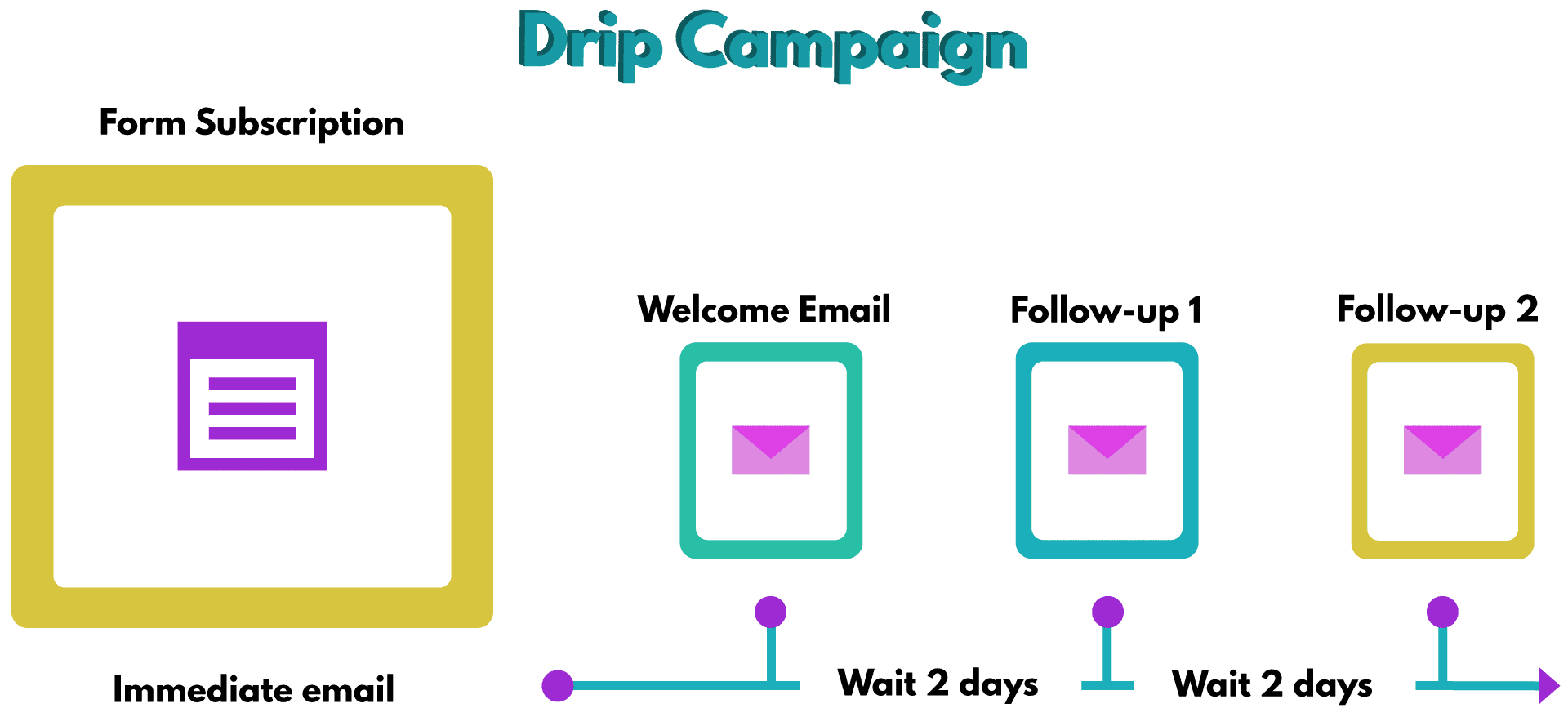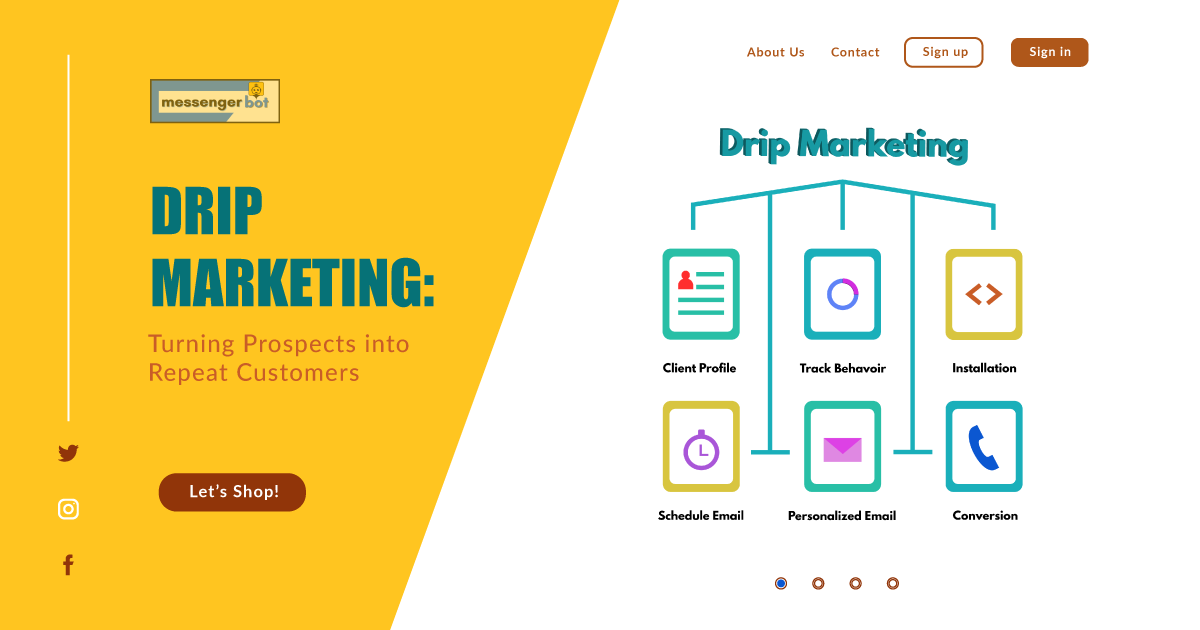Drip marketing is a strategy that many businesses use to keep in touch with their customers. It involves sending out content, offers, and other information to your prospects regularly, which increases the chance of them becoming repeat customers. Drip marketing can be done through email campaigns or social media updates. The key is consistency and relevance; if you are not consistent then it will be hard for people to remember who you are when they need what you offer – but if you send relevant messages consistently over time then this will increase the chances of people buying from you again!
What is drip marketing theory?
Drip marketing is a direct marketing strategy for nurturing potential customers into loyal and repeat buyers.
Drip marketing campaigns are designed to keep prospects engaged with your brand or product over time by delivering small, targeted doses of content that highlight different aspects of what you offer. Seeing your marketing message once will not do the trick.
Drip marketing is all about building the relationship between you and your prospect so they know, like, and trust who you are before they need to invest in your company. It’s not just one campaign – but many! Think about creating a series of drip campaigns rather than one dump where everything at once hoping that some will stick.

What are drip campaigns?
Drip campaigns are automated marketing campaigns that drip out content over time. They are a subset of email marketing and are often used to nurture leads.
Drip campaigns are a powerful tool for marketers because they give customers the chance to start following your company’s updates and products without being bombarded with messages. Instead, you can provide them with content on their own timeline which will make them feel more connected to your brand. Plus, drip campaign subscribers might also be receptive to marketing offers when it comes time to buy something from you.
Lead Nurturing helps convert leads into sales by providing information that appeals specifically to each prospect based on their needs or stage of interest with your business. It starts slow but gradually becomes more aggressive as prospects become closer and closer towards making a purchase decision–ultimately resulting in higher conversion rates.

How is lead nurturing used in drip marketing campaigns?
Lead Nurturing is a popular strategy for companies that want to turn prospects into repeat customers. They work by sending automated messages over time, guiding them from one stage of the buyer’s journey to another until they become buyers. Here are some examples:
– Drip emails/newsletters might show up in your inbox with weekly tips on how best to use or care for something you purchased recently
– You may receive an email asking if there is anything about particular products or services that you need help understanding before making a purchase decision
– A company might send a newsletter with discounts and other special offers to encourage repeat purchases
Drip marketing is an effective way for companies like yours to capture your prospects’ interest, nurture them into becoming customers, and eventually turn them into loyal advocates.

Why is drip marketing effective?
Drip marketing works because it offers prospects a continual stream of relevant information. This way, there’s never any interruption in the relationship between you and your prospect. It also makes sure that they’re not overloaded with information at once – so people are more likely to stay interested for as long as possible. Drip marketing is also known as an automated email campaign.
When it’s done right, a drip campaign is personalized to each person’s interests. It also gives them the sense of exclusivity because they know that only they’ll be receiving these messages – which makes people feel special. And finally, an email campaign can go a long way in creating sales opportunities for when they’re most receptive. This means that even if someone doesn’t place their order immediately but decides, later on, there will always be something available based on whatever success criteria you’ve set up for yourself.
To be successful with drip marketing, however, all communications need to have tangible value or benefit for the recipient. Emails without content will quickly get deleted or ignored; make them count by giving potential customers valuable insights into products and services that would help solve their problems or answer their questions regarding what you do best.

How does a drip campaign work?
Drip campaigns were in the form of direct mail before. Nowadays, it’s not only mailing campaigns that can be created as drip campaigns. Emails and SMS messages are also used to create a drip campaign.
The purpose of these emails or texts with incrementally increasing offers in them is to turn prospects into repeat customers by giving them more reasons than they could find elsewhere for buying from your company. This usually happens when somebody has been considering investing for quite some time and isn’t sure if this particular product or service will meet their needs before actually committing themselves to purchase anything at all.
Drip campaigns work through the use of automation, segmentation, and timing to create a sense of urgency in your prospects. Automated messages remind them that they haven’t ordered yet and offer another incentive if they do so within 24 hours.
Segmentation breaks down customers into groups based on their needs – this way you can send emails or other marketing materials specifically tailored for each group (i.e., new parents vs retirees) with an appropriate call-to-action at the end of it. Timing is important because once someone clicks through from your email campaign onto your website, how long will it take before getting them back? What about retargeting visitors who didn’t buy but were interested in a particular product?
What are the keys to a successful drip marketing campaign?
Drip campaigns can be very effective when it comes to clear conversion objectives- even if not all prospects will convert right away, these initiatives ensure that each prospect has exposure to relevant information at every stage so as soon as paying customers to come along, they are ready to go.
The key is in the drip content, which should be designed with conversion as your top priority. This can mean anything from a sign-up form or lead magnet at the end of an email sequence for prospects to complete, to more traditional marketing tactics like advertising on social media platforms and paid search ads that target people based on their emails IDs (if you have permission). The point is these initiatives need to constantly engage customers so that when it comes time to make a purchase decision they’ll choose you over competitors again and again.
Here are tips to create a successful drip campaign.
Use marketing automation tools
Automated drip campaigns are a great way to consistently attract and convert your prospects into repeat customers, by delivering the right message at just the right time.
Automated drip campaigns offer consistent messages through email, social media, and other channels that are tailored for different segments of your audience based on their interests and behavior.
By applying this method, you can be sure that people will see what you want them to see when they need it most. This strategy takes some work up front- but in return, it gains momentum with each new contact in every channel. Automation is also scalable: if one campaign doesn’t cut it, you can simply create additional ones without exhausting valuable resources or taking too much time from any individual project!
Messenger is an automation and chatbot tool that can help you create and execute an automated campaign to turn prospects into customers.
You can use Messenger’s automation tools to segment your audience by interests or behaviors so you know who needs what message when they need it most!

Measure ad performance
Your ad performance is an important part of your drip campaign. You need to measure how well your ads are doing, and then improve them accordingly.
You want to see how many people clicked through from the ads that appear in a marketer’s email message. It is also important to know if those clicks led to conversions–that is, sales or signups for newsletters or products. This information will help marketers direct their content strategy by knowing which marketing channels have the most success with customers and prospects alike. Targeted ads are important to a lead nurturing campaign.

Measure content performance
Content performance is one of the most important aspects of any marketing campaign, and a drip campaign is no exception. There are many metrics to measure content performance – engagements, traffic sources, time on page or site, social shares, and more. These measurements can highlight strengths and weaknesses in your content strategy that you may not have otherwise been aware of.
Monitoring various types of measurement along with viewing qualitative feedback from customers will give insights into what resonates best with your audience and what type of messages work best for them. This information can be used when creating future campaigns both large-scale like a website redesign but also small scale such as an email communication template update.
To get the most out of your drip campaign, it is important that you regularly assess what content has been successful and why, as well as what needs improvement. Monitoring performance metrics can help identify patterns in customer behavior which will allow for more effective targeting of future campaigns and better communication with customers who have already engaged. This feedback loop should be a continuous process and not something done once at the end of an initiative or on some arbitrary timetable – there are always new things to learn about how your target audience behaves online!
This knowledge translates into increased sales through having an understanding of where marketing dollars are going after being spent, whether generated by direct response advertising like PPC ads or brand awareness efforts such as SEO outreach.

Generate audience insights through market research
Audience Insights can be generated through market research. Market research can help marketers create more effective and targeted marketing campaigns, which ultimately leads to higher conversion rates.
Marketing tools such as surveys and polls can be used to capture feedback from potential customers, this information will help you understand the types of content they are interested in receiving.
Marketers often create a series of emails with relevant messages for their target audience that aligns with their interests or needs. Marketers may also utilize customer relationship management (CRM) software that assigns points based on purchases and other actions which then allow marketers to build segments into drip marketing campaigns. This CRM data is an excellent way to know your prospect’s trends so it can be addressed accordingly during each campaign phase. Not only does using market research provide valuable insight about what type of messaging prospects want, but it also allows marketers to tailor their drip campaigns for increased effectiveness.

Display personalized ads
Personalized ads are one of the most powerful tools in a marketer’s arsenal.
Drip marketing is all about reminding people to purchase again, and personalized ads can do that better than any other tool. You know what your customers like, so you should use their data to show them products they’ll be interested in while also remembering when it was time for them to buy something new or replenish an existing product. Personalized ads are a great way to remind someone who has been browsing but hasn’t placed an order yet.

Use precise geolocation data
Geolocation data is used to target individual customers with personalized messages and offers. For example, if you’re a coffee shop in Brooklyn, NY (NYC), the software will show your customer how many minutes they’ll save by visiting your store instead of driving into Manhattan.
Geolocation data is also an important tool for:
– Establishing local relevance – not all locations are created equal!
– Generating new leads
– Improving conversion rates on social ads by providing precise information about the location
In addition, geolocations can be filtered to help marketers narrow down their audience size before uploading content or sending out notifications. It’s always best practice to use as much location detail as possible so that you know exactly who’s getting your message.

Conclusion
Email drip marketing is becoming more popular today for customer acquisition. An effective drip campaign is personalized, timely, and relevant. It’s important to include geolocation data in your drip campaign so you can target the customer with offers that are specific to their location.
In conclusion, email marketing campaigns have become popular today for acquiring customers. An effective drip campaign includes personalization of the message based on timing as well as the relevance of content tailored towards a particular individual or group. Remembering to incorporate geolocations into these campaigns will ensure you’re sending out messages customized and applicable to a person or area they represent.
Messenger Bot is a great platform to start your drip-feed campaigns. with automation and insights, you can create a campaign that is engaging and personalized to your audience. Get started for free today!




